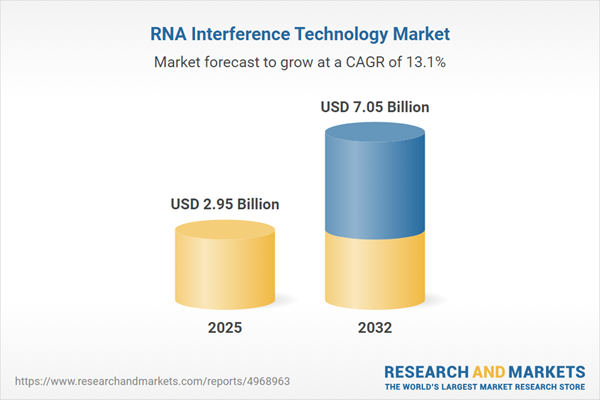Speak directly to the analyst to clarify any post sales queries you may have.
The RNA interference technology market is expanding as organizations worldwide deploy advanced gene-silencing tools in research, drug development, and emerging therapeutics. Continuous innovation in RNAi delivery and increasing clinical adoption are transforming the sector, shaping new opportunities for stakeholders navigating complex regulatory and operational environments.
Market Snapshot: RNA Interference Technology Market Size & Growth
The RNA Interference Technology Market grew from USD 2.63 billion in 2024 to USD 2.95 billion in 2025. It is expected to continue growing at a CAGR of 13.08%, reaching USD 7.05 billion by 2032. Steady growth is fueled by ongoing advancements in gene-silencing platforms, increased therapeutic interest, and broadening application across key segments of biopharmaceutical research. These trends illustrate both sustained industry expansion and rapid evolution in RNAi-based solutions.
Scope & Segmentation of the RNA Interference Technology Market
- Molecule Types
- MicroRNA (miRNA)
- Short Hairpin RNA (shRNA)–encompasses both non-viral and viral delivery mechanisms
- Small Interfering RNA (siRNA)–incorporates both conjugated and non-conjugated approaches
- Routes of Administration
- Intramuscular (IM) Injection
- Intrathecal (IT) Administration
- Intravenous (IV) Injection
- Delivery Methods
- Direct Naked RNAi Delivery
- Exosome-Based RNAi Therapy
- Nanoparticle-Based Delivery
- Viral Vector-Based Delivery
- Applications
- Drug Discovery (including lead optimization and target identification)
- Research & Development (focusing on gene function and pathway analysis)
- Therapeutics
- End-User Profiles
- Contract Research Organizations
- Hospitals & Clinics
- Pharmaceutical & Biotechnology Companies
- Regional Coverage
- Americas: including United States, Canada, Mexico, Brazil, Argentina, Chile, Colombia, Peru
- Europe, Middle East & Africa: encompassing United Kingdom, Germany, France, Russia, Italy, Spain, Netherlands, Sweden, Poland, Switzerland, United Arab Emirates, Saudi Arabia, Qatar, Turkey, Israel, South Africa, Nigeria, Egypt, Kenya
- Asia-Pacific: covering China, India, Japan, Australia, South Korea, Indonesia, Thailand, Malaysia, Singapore, Taiwan
- Key Market Players
- Alnylam Pharmaceuticals, Inc.
- AMSBIO
- Arbutus Biopharma Corporation
- Arcturus Therapeutics Holdings Inc.
- Arrowhead Pharmaceuticals, Inc.
- Atalanta Therapeutics
- Bioneer Corporation
- Dicerna Pharmaceuticals, Inc.
- Gradalis, Inc.
- Horizon Therapeutics plc
- Ionis Pharmaceuticals, Inc.
- Merck KGaA
- Novartis AG
- Nutcracker Therapeutics, Inc.
- Phio Pharmaceuticals Corp.
- ProQR Therapeutics N.V.
- Sanofi S.A.
- Silence Therapeutics PLC
- Sirnaomics, Inc.
- Thermo Fisher Scientific Inc.
- Vir Biotechnology, Inc.
Key Takeaways for Senior Decision-Makers
- RNA interference technology serves as a foundational driver for innovation in genomic medicine, enabling both transient and stable modifications in gene expression.
- The commercial landscape is shaped by strategic alliances, licensing, and rapid advancements in delivery platforms, positioning key players for portfolio expansion.
- Differentiation among molecule types, such as microRNA, shRNA, and siRNA, allows tailored solutions for research, therapeutic validation, and clinical translation.
- End-users—including CROs, healthcare providers, and biopharma companies—play critical roles in adoption curves and technology commercialization.
- Regulatory evolution and harmonization across regions are facilitating streamlined development pipelines and accelerating the time-to-market for novel RNAi-based therapies.
- Robust supply chain management and proactive mitigation strategies are increasingly vital as the sector encounters disruptions from evolving global trade policies.
Tariff Impact on Market Dynamics
The introduction of United States tariffs in 2025 on essential materials—such as specialized lipids, polymers, and oligonucleotide reagents—has intensified cost pressures and exposed vulnerabilities within RNAi technology supply chains. These shifts compel organizations to diversify sourcing, reassess procurement strategies, and pursue greater resilience through vertical integration and collaborative partnerships. Smaller entities, in particular, face the dual challenges of input inflation and inventory delays, highlighting the importance of operational flexibility.
Methodology & Data Sources
This report integrates comprehensive secondary research, including scientific publications, patent filings, and regulatory data, with targeted primary interviews across senior industry stakeholders. Analytical rigor and data triangulation techniques ensure authoritative, actionable insights into RNA interference technology trends and market drivers.
Why This Report Matters
- Offers senior leaders clarity on evolving therapeutic and research applications in the RNA interference field.
- Supports informed strategic planning by highlighting supply chain risks, emerging alliances, and driver trends in next-generation RNAi delivery.
- Provides granular segmentation and regional insights essential for investment and competitive positioning.
Conclusion
RNA interference technology is redefining gene modulation strategies in both research and therapeutics. Decision-makers equipped with current segmentation, regulatory, and supply chain perspectives will be best positioned to seize growth opportunities in this dynamic market.
Additional Product Information:
- Purchase of this report includes 1 year online access with quarterly updates.
- This report can be updated on request. Please contact our Customer Experience team using the Ask a Question widget on our website.
Table of Contents
3. Executive Summary
4. Market Overview
7. Cumulative Impact of Artificial Intelligence 2025
Companies Mentioned
The companies profiled in this RNA Interference Technology market report include:- Alnylam Pharmaceuticals, Inc.
- AMSBIO
- Arbutus Biopharma Corporation
- Arcturus Therapeutics Holdings Inc.
- Arrowhead Pharmaceuticals, Inc.
- Atalanta Therapeutics
- Bioneer Corporation
- Dicerna Pharmaceuticals, Inc.
- Gradalis, Inc.
- Horizon Therapeutics plc
- Ionis Pharmaceuticals, Inc.
- Merck KGaA
- Novartis AG
- Nutcracker Therapeutics, Inc.
- Phio Pharmaceuticals Corp.
- ProQR Therapeutics N.V.
- Sanofi S.A.
- Silence Therapeutics PLC
- Sirnaomics, Inc.
- Thermo Fisher Scientific Inc.
- Vir Biotechnology, Inc.
Table Information
| Report Attribute | Details |
|---|---|
| No. of Pages | 184 |
| Published | November 2025 |
| Forecast Period | 2025 - 2032 |
| Estimated Market Value ( USD | $ 2.95 Billion |
| Forecasted Market Value ( USD | $ 7.05 Billion |
| Compound Annual Growth Rate | 13.0% |
| Regions Covered | Global |
| No. of Companies Mentioned | 22 |









